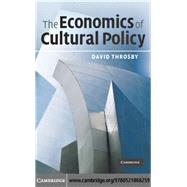
Note: Supplemental materials are not guaranteed with Rental or Used book purchases.
Purchase Benefits
What is included with this book?
| Preface | p. ix |
| Acknowledgments | p. xiii |
| Abbreviations | p. xv |
| Introduction | p. 1 |
| The changing face of cultural policy | p. 1 |
| The policy response | p. 5 |
| Outline of the book | p. 8 |
| The scope of cultural policy | p. 14 |
| Introduction | p. 14 |
| Cultural goods and services | p. 15 |
| Value and valuation | p. 17 |
| Composition of the cultural sector | p. 22 |
| Production, distribution, consumption | p. 24 |
| Cultural policy in government administration | p. 28 |
| Conclusions | p. 30 |
| The policy process | p. 32 |
| Introduction | p. 32 |
| Economic objectives of cultural policy | p. 34 |
| Artistic and cultural objectives of cultural policy | p. 41 |
| Instruments | p. 45 |
| Monitoring and evaluation | p. 53 |
| Conclusions | p. 55 |
| Arts policy | p. 58 |
| Introduction | p. 58 |
| What is arts policy today? | p. 59 |
| Direct support | p. 63 |
| Indirect support | p. 73 |
| The role of the individual artist | p. 80 |
| Conclusions | p. 83 |
| Appendix to Chapter 4 | p. 84 |
| Cultural industries | p. 88 |
| Introduction | p. 88 |
| Conceptualising the cultural industries' role in the economy | p. 90 |
| Assessing the economic contribution of the cultural industries | p. 93 |
| Industry dynamics: economic and cultural growth | p. 98 |
| Policy strategies for the cultural industries | p. 100 |
| Conclusions | p. 103 |
| Cultural heritage | p. 106 |
| Introduction | p. 106 |
| Heritage as asset | p. 107 |
| Value | p. 108 |
| Policy issues in heritage management | p. 113 |
| Public policy and built heritage | p. 117 |
| Public policy and moveable heritage | p. 121 |
| Public policy and intangible heritage | p. 125 |
| International dimensions to heritage policy | p. 126 |
| Conclusions | p. 127 |
| Culture in urban and regional development | p. 131 |
| Introduction | p. 131 |
| Concepts | p. 132 |
| Creativity in an urban context | p. 136 |
| The role of architecture | p. 140 |
| Policy conclusions | p. 142 |
| Tourism | p. 146 |
| Introduction | p. 146 |
| Economic aspects of tourism | p. 147 |
| Cultural issues in mass tourism | p. 151 |
| Cultural tourism as a niche market | p. 152 |
| Policy conclusions | p. 154 |
| Culture in the international economy | p. 157 |
| Introduction | p. 157 |
| Cultural trade | p. 158 |
| Non-trade issues in international cultural relations | p. 166 |
| Conclusions | p. 169 |
| Cultural diversity | p. 171 |
| Introduction | p. 171 |
| The value of cultural diversity | p. 171 |
| The origins of diversity as an issue in cultural policy | p. 173 |
| The UNESCO Convention process | p. 175 |
| Policy implications | p. 177 |
| Conclusions | p. 179 |
| Arts education | p. 181 |
| Introduction | p. 181 |
| Economic analysis of education | p. 181 |
| Arts education in schools | p. 184 |
| Education and training of artists | p. 186 |
| Education as a determinant of arts consumption | p. 188 |
| Conclusions | p. 189 |
| Culture in economic development | p. 191 |
| Introduction | p. 191 |
| Culture in development | p. 192 |
| Culture and sustainability | p. 194 |
| Policy implications | p. 196 |
| Conclusions | p. 197 |
| Intellectual property | p. 199 |
| Introduction | p. 199 |
| The economic basis for copyright | p. 200 |
| Administration of artists' rights: the economic rationale for collecting societies | p. 203 |
| The effect of new technologies | p. 208 |
| International regulation of copyright | p. 209 |
| Copyright in development | p. 210 |
| Conclusions | p. 211 |
| Cultural statistics | p. 214 |
| Introduction | p. 214 |
| Types of cultural statistics | p. 215 |
| Some special-purpose statistics | p. 224 |
| Towards a new framework for cultural statistics | p. 227 |
| Conclusions | p. 229 |
| Conclusions | p. 231 |
| References | p. 237 |
| Name index | p. 260 |
| Subject index | p. 265 |
| Table of Contents provided by Ingram. All Rights Reserved. |
The New copy of this book will include any supplemental materials advertised. Please check the title of the book to determine if it should include any access cards, study guides, lab manuals, CDs, etc.
The Used, Rental and eBook copies of this book are not guaranteed to include any supplemental materials. Typically, only the book itself is included. This is true even if the title states it includes any access cards, study guides, lab manuals, CDs, etc.